|
Monday, August 22, 2011
Progress Notes
On the Progress Notes of June 20, 2011 I presented the story of Aurora Springs based on an old promotional booklet given me by Floyd “Red” Norman of Aurora Springs (photo 01).
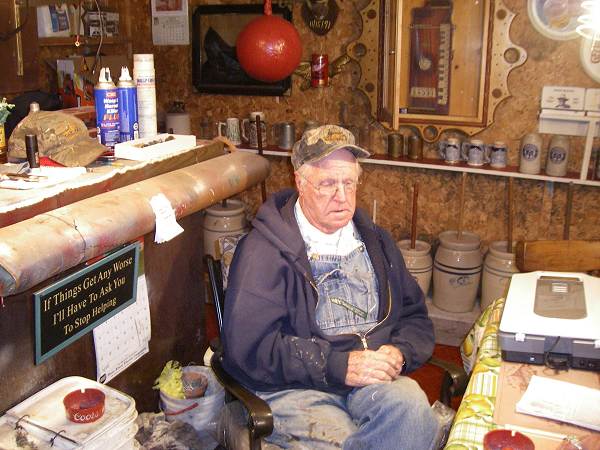
01 "Red" Norman
Floyd was born in Henley but at the age of 8 years old his family moved to Aurora Springs. Floyd is well known in the area as being a building constructor, developer, dealer and trader. He lives in a home located at the top of a small hill in Aurora Springs where he has placed signs reading “Norman Hill.” Floyd also gave me a book about Henley, the home town where he was born. This book was written by Anna Mae Whittle, a Henley native who passed away several years ago. Ms. Whittle accompanied her narrative with many photos of the town of Henley making it that much more interesting.
Henley is like Eugene in that both communities, which are located just over the county line in Cole County, have much in common with Miller County. Residents of Eugene and Henley over the many past years often have moved to Miller County or had relatives here and conducted business here. Likewise, quite a number of northeastern Miller County students go to Eugene for their education as do Henley students.
I had written in a previous Progress Notes that former Miller County Historical Association board member Helen Gibson’s great great grandfather, John Henley, was the one who settled in Henley and it was his son William Henley for whom the town was named (photo 02).
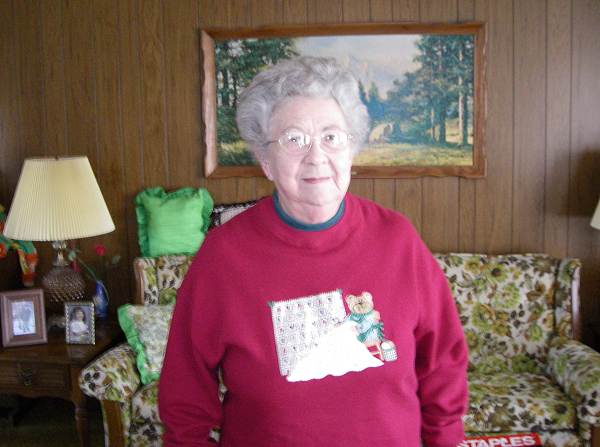
02 Helen Gibson
Jasper Henley, son of John, and great grandfather of Helen, was raised in Henley but later came to Miller County to live (photo 03).
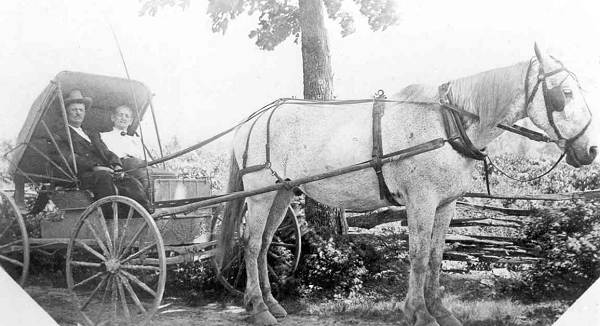
03 Jasper and Julia (Norfleet) Henley
So there has been a close association between the town of Henley and Miller County even though Henley is located just short distance away in Cole County.
You can read more about Helen Gibson’s Henley descendents at this previous Progress Notes.
To drive to Henley take Route BB east off Highway 17 one mile north of Eugene or a half mile south of Highway 54. Follow Route BB for about four and a half miles and then turn right to the south on Rte. H. After about a mile you will arrive at Henley.
Ms. Whittle’s book is about her memories of growing up in Henley and is interesting for a number of reasons including not only the history of the town but also a first person experience of how life was lived there many years ago. Nowadays, Henley, like Tuscumbia and other small towns of the area, no longer is the vibrant busy community it once was. But its history is typical of the area and features the stories of people well known in this area. So this week I will present Ms. Whittle’s book about Henley.
PREFACE
The present work is an attempt to tell the past history of Henley. I have documents, pictures, data from the Courthouse in Jefferson City, Missouri, and stories told me by members of the families who once lived here and made the town. To the best of my knowledge the information I have gathered is true. I know some would have more accurate information, but I have been unable to obtain it.
I wish to express my appreciation to those who gave me information and to those who loaned me pictures. To my husband, “Jack” (Markel Edward) Whittle, he has been most helpful in his knowledge of the history of Henley. To my very dear friend, Genevieve Harter (Mrs. Carroll Edward) Nelson, without her help this book would never have been published.
Anna Mae Whittle
Henley, Missouri
Autumn, 1989
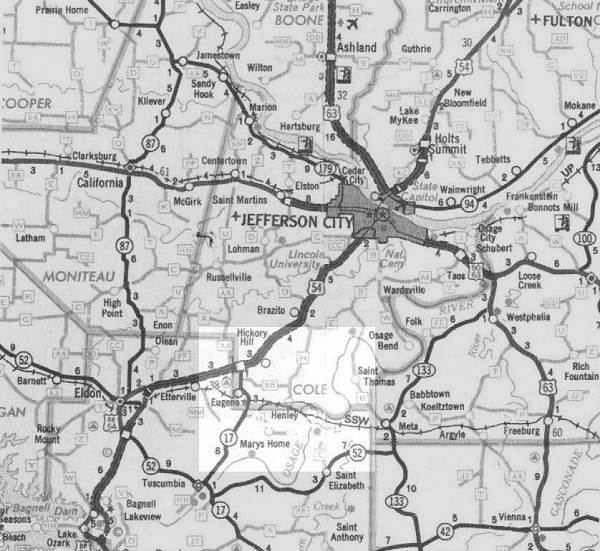
Henley on Map
It is the autumn of 1989. Approximately twenty miles south of Jefferson City, Missouri’s state capital, on 54 Highway past E at the end of Route H, lies the small town of Henley. Winding down through acre after acre of Cole County, Route H blacktop, you can see wild turkeys, an open field where deer are grazing, cows feeding in lush green meadows, squirrels scampering across the roads, patches of woods where you can se a timber wolf, coyote, raccoon or opossum.
In spring the wild white dogwood trees in bloom make a white covering that is so beautiful in and around the wood. Tortoises, on their slow move across the road, where, if lucky, make it before being crushed by a car.
Winding on down a big hill, a large lake is at the foot with trailers lining the frontage. There you may see a crane fishing for his meal of fish, coots or wild ducks on the water; and on down is the city limit sign that reads “Population, 54.” The town of Henley lies amidst tall magnificent tree laden hills. The trees, untouched by man, are left to tower over their lofty domain.
Cole County was organized November 16, 1820, named after Stephen Cole, a noted pioneer and Indian fighter. Cole was killed by an Indian in 1822. Clark township was opened for homesteading in 1824; Southern and Western Sections were purchased from 1836 to 1859, all being the property of private owners before the Civil War! To the best of my knowledge, John Legate Henley was the first Henley to settle in Clark township.
John Legate Henley was born in 1797, in Washington County, Tennessee. He was married to Elizabeth Hoskins. They came to Cole County, Clark Township in 1833, settled around Henley, Missouri, in 1847; he died in 1878.
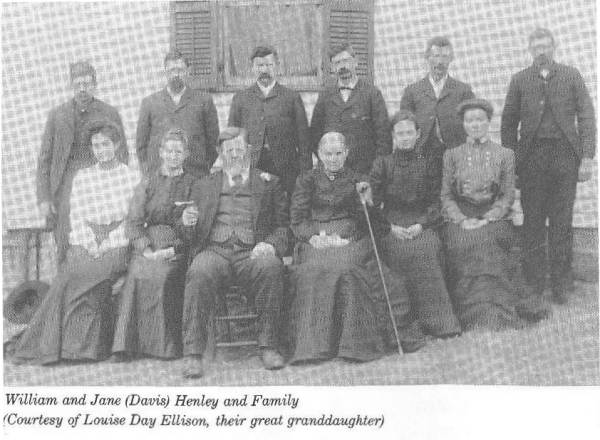
William and Jane (Davis) Henley and Family
His children were:
James, born 1817, in Tennessee; married Nancy Duncan; Mary, born 1819; married William Bar; John, born 1824; married Nancy Moore; Greenberry, born 1825, married Jane Davis; Louisa, born 1833, married John Riggins; Margaret Ann, born 1835, married Milton Moore; Jasper, born 1837, married Mary Jane Shipman.
On August 26, 1882, John Henley Sr.’s estate went to James Henley. He was reared to farm labor. At the early age of twenty five, he bought a tract of forty acres on which he built a blacksmith shop, having learned the trade from his father. On his twenty fifth birthday he married Miss Nancy Duncan, whose father was also an early settler. He added to his original purchase from time to time. One purchase from which I have a record was on November 12, 1855, from Mr. Burel Burton. With his growing family to assist him, he soon became one of the prominent farmers of the county. In 1889 he was the owner of some 2,000 acres of land, 700 of which was under cultivation, most of it being in the creek bottom and very productive.
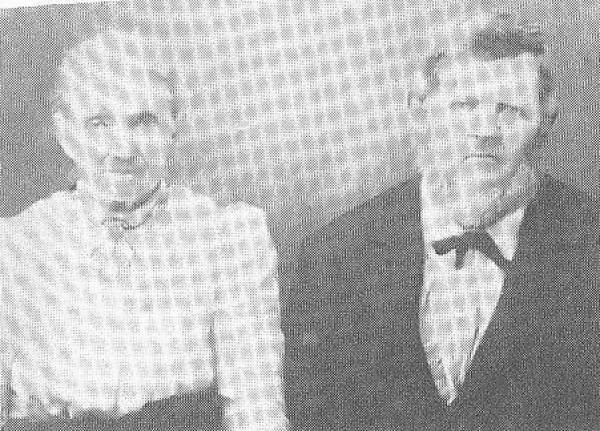
William and Jane Henley
James was the eldest son of John Legate Henley. His younger brother was William Henley, born October 8, 1828. William married Jane Davis on March 16, 1854.
William began to buy land in Henley and around until he owned several hundred acres:
April 15, 1857, 60 acres from Peter Rose;
In 1869, August 25, from John Jr.
On February 7, 1874, from John Sr.
On December 18, 1902 William and his wife deeded 500 acres to the Henley Townsite Company (which included all but the Rock Island Railroad right of way), which now in autumn of 1989, is the town of Henley.
Also was deeded a plot of land July 29, 1907, to the Blue Oak Handle Factory. Mr. G.R. Meek was treasurer of the company.
The children of William and Jane were:
John married Missouri Fowler;
Thomas Green married Josephine Lumpkin;
Ronnie Aromel
(A.T.) married Ollie Pendelton
Peter married Julie Fowler
Minnie married Burdette Jones;
Ethel married Skyler Norfleet;
Aldomas married Mattie;
Alice married “Billy” (William) Pendleton;
Gilpin married Annie Dixon
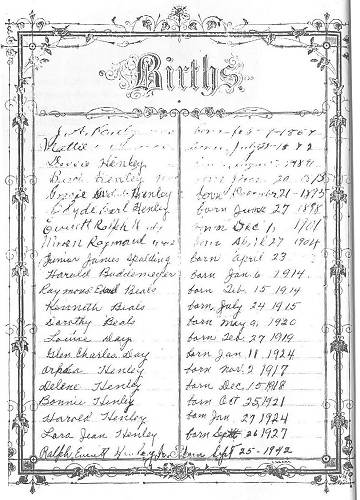
Birth Record
Click image for larger view
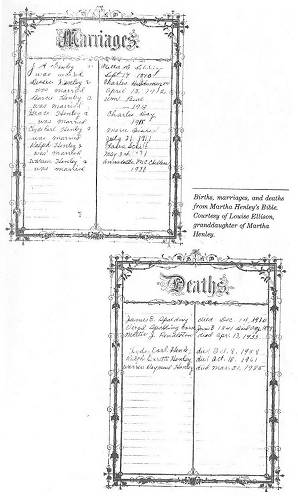
Marriage and Death Record
Click image for larger view
Back in the middle and late 1800’s and early 1900’s, the dirt and gravel road wound down a big hill where at the bottom lay a natural spring. As the wagons and buggies came to Henley, they would stop to water their horses and drink the pure, cold spring water. A tin cup or dipper was always there.
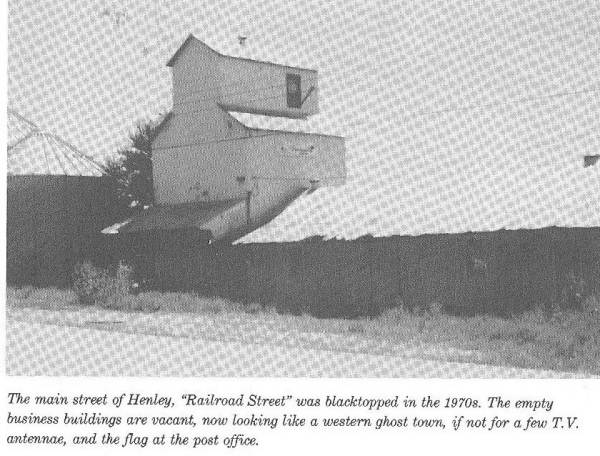
Railroad Street - Main Street of Henley
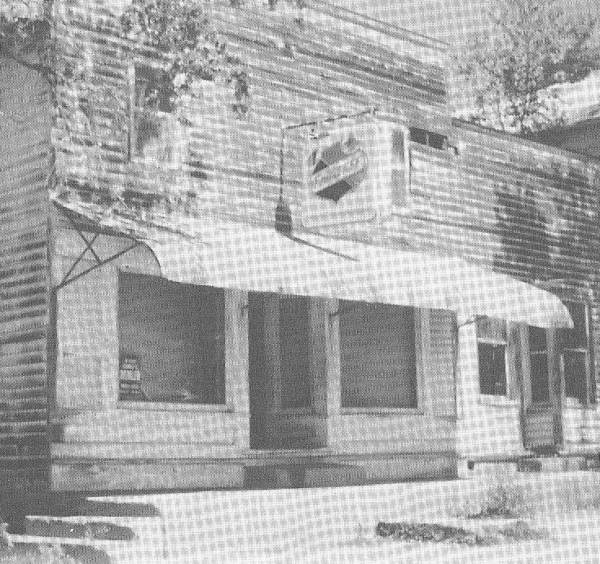
Vacant Building
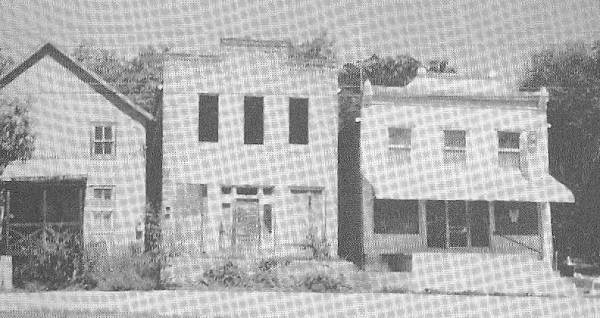
Vacant Buildings
Down a little farther was a beautiful lake. The lake was built by the Rock Island Railroad, dug by men and teams of horses in late 1900 and early 1901. Its purpose was to furnish water for the steam engines. It ran down to a big water tower in Henley. The contractor boss was a man named Hughes. They named the lake “Fisherman’s Paradise.”

Fishing Paradise
It was a slow process to build back in that time. Winding down to Henley was the first house built by John Henley in 1800. It was a stately two story house. It had porches across the first and second levels which looked more like a hotel.
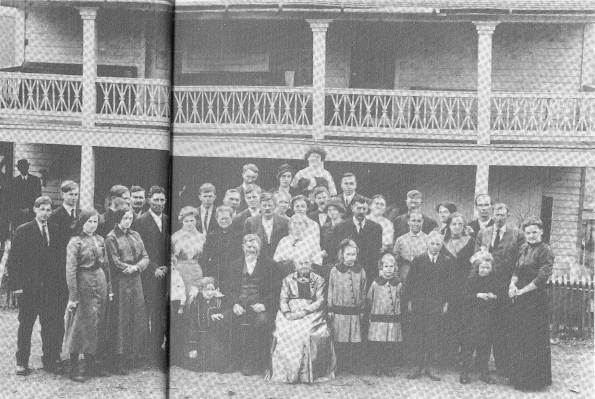
William and Jane Henley 65th Wedding Anniversary at their home - 1916
It had a log cabin slave house with a walkway between it and the main house. Henley kept slaves in log house. It was torn down some time in the later 1920’s. The main house stood in its decaying state although you could still see its regal beauty. This historical house was torn down in the mid 1970’s. Artists came from Chicago, Missouri University at Columbia, and other places to photograph and paint this hotel like house. John Henley, William’s father, had sold the land and house to William, who plotted the town of Henley in the early 1900’s. The town was named for him.
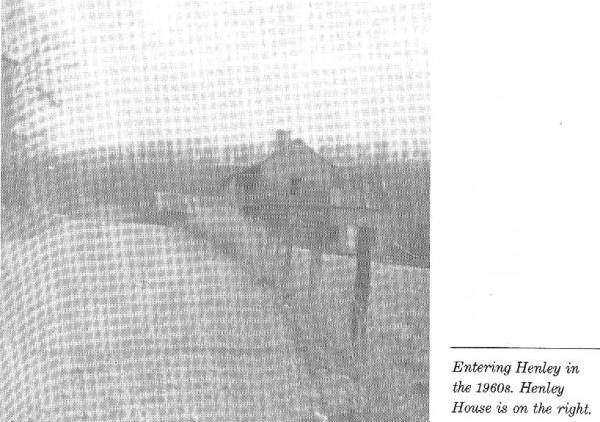
Entering Henley in the 1960's - Henley House on Right
With the railroad in 1901 came the busy, bustling and booming town, with two stores, post office, telephone switchboard, school, stockyard, barber shop, bank depot, restaurant, three charcoal kilns, grain elevator, creamery, saloon, two hotels, two blacksmith shops, two garages, an axe handle factory, two churches and two tiff mines.
When the railroad was being built and even before, there were as high as forty five tents below where the tracks are now. The tents extended from the little railroad bridge town along the creek toward the river, and were washed out at times. The Rock Island was built in 1901.
Two stores were built, one by William Reavis, the other by a man named Ivens. At that time, the depot was built. The passenger trains ran from Kansas City and St. Louis, Missouri. They met in Henley at 12:00 noon and 12:00 midnight. During the war in 1940, troop trains would pass, carrying as high as ten or twelve cars filled with boys.
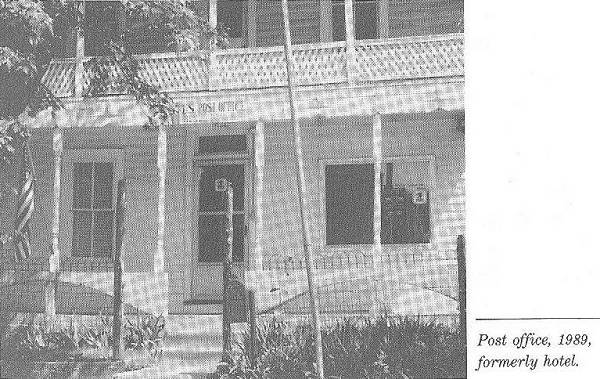
Post Office - 1989 - Formerly Hotel
My brother came from Jacksonville, Illinois on one of the troop trains, and as it passed through Henley he said he would have given anything to jump off.
My grandfather, L.F. Sullens, lived about three miles west from Henley on what is now known as highway BB. My mother and I would arrive some time at midnight. We would walk that distance to Grandpa’s. I will never forget. I was just a small little girl and began to lag behind. My mother would start telling me ghost stories, old tales about the lake being haunted, such as a baby crying that drowned, two men carrying a coffin, and as we passed by the lake my tired little legs would sure get moving for awhile.
A telephone switchboard building was built, a two apartment house with the switchboard on one side, and a millinery shop on the other. The millinery shop was run by a woman named “Miller.” When the hat shop went out, Hansford Burks moved in. He ran the switchboard and the post office which also was in it at that time. He operated both until the house burned in the early 1930’s.
There were two hotels, built before 1904. One hotel burned. Jim Houser owned it at that time. I have not the date of the burning. The building was built by Judge Smith, Kearney Smith’s father. It sat where Mark Belshe later built his house, now owned by Earl Russell.
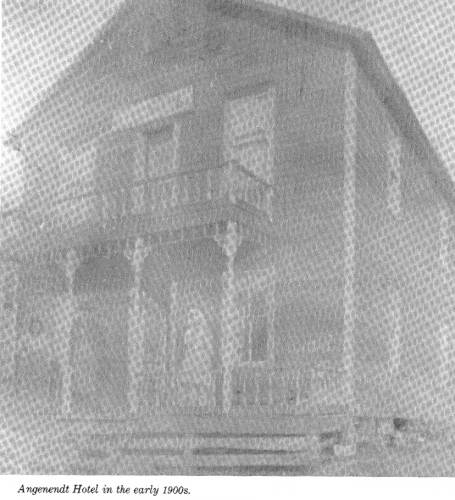
Angenendt Hotel in the early 1900's
The second hotel, which is now the post office was built by Katie Sebilla (Ivens) Angenent, grandmother to Theodore William Angenendt. She ran it for several years. After Angenendt, M.M. Busche owned it and ran it. In 1904 Joe Jakes owned the hotel (Ed. Note: the Carroll E. Nelsons’ recall eating breakfasts there in 1933). She was the last person to run the hotel.
A woman by the name of McCallister lived in the building that was later rebuilt for the Henley Bank. After McCallister’s death, several other families lived in the building.
Virgil Frances opened a store and ran it for sometime. The Henley Bank on this location was opened in 1917.

William Reavis store when first built in the early 1900's
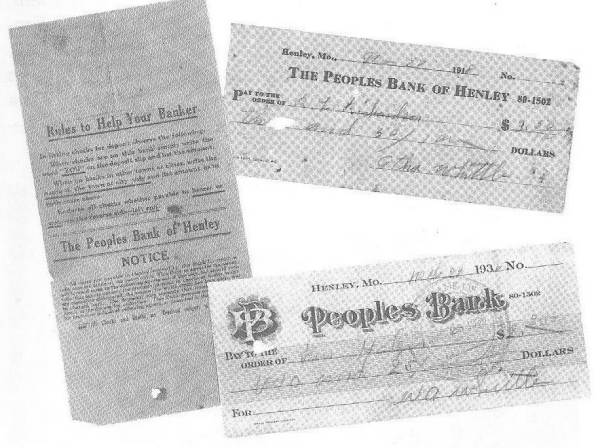
Cancelled Checks from The Peoples Bank of Henley
The bank thrived for several years. George Carney was president. Jake Kempker worked there. Jess Longenbrink was president when the bank closed during the depression years. As my father in law Atha Whittle’s cancelled checks show, the last one was written March 21, 1936, so I assume that it closed about that time. I have no picture of the bank building with the Henley Bank on it.
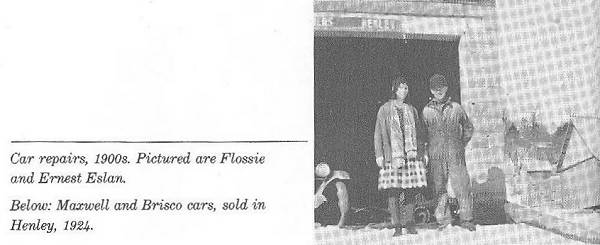
Car Repairs - 1900's - Pictured are Flossie and Ernest Eslan
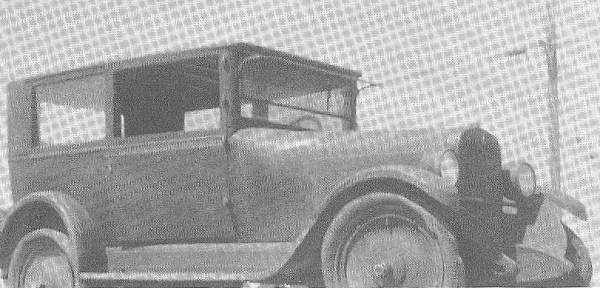
Maxwell and Brisco Cars - Sold in Henley - 1924
In the early 1900’s, Osby reavis built a huge garage across from the Henley House. He sold Maxwell and Brisco cars. I have only a picture of the rear of the garage. Some of the men who worked in the garage for Osby Reavis were: Adrian “Crick” Miller; Atha Whittle; John and Mark Belshe; and maybe more.
Frank Kempker took over the garage in 1926, selling Chevrolet cars. Some of the men who worked for him were: Barney Meyerpeter, “Corney” Krause, Otto Strope, and Otto Strope’s brother “Slim Strope. William Carrender either worked for Frank Kempker or Asby Reavis, or maybe both. I may have missed some that have worked for both of them. After Frank Kempker in the early part of 1943, Charles Emmerich Sr. took over the garage and ran it until late 1947. The blocks from the garage, when torn down in 1950, were taken to Marys Home to help build the Knights of Columbus Hall. The concrete floor of the garage is still there. The second garage by Mark Belshe’s house was run by him.
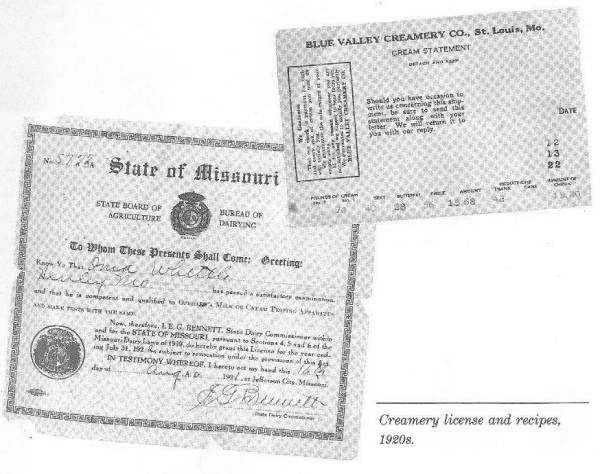
Creamery License and Recipes - 1920's
At the time when Frank Kempker ran the garage, there were fifteen or twenty young men in the neighborhood. One Halloween on Saturday night, they took a cow and penned her up inside the garage. As the garage was opened up on Monday, there was the cow. They even hoisted a buggy on top of the water tank.
William Jacob “Billy” Miller had a blacksmith shop just above the telephone switchboard, a little way up the hill, and lived in a house beside the shop. The old well casing is still there. William Miller was also a notary. Adrian Miller ran the creamery in 1916. It was just below the charcoal kilns. Adrian lived in the house that we live in now, just above the creamery on the hill. The house was built in 1898 or 1900, somewhere in that area. My husband Jack’s mother and dad, Omma and Atha Whittle, ran the creamery in 1921. The receipts we have of the sale of the cream are to the Keystone Creamery Company. I don’t know for sure where it was located, but a receipt from Blue Valley Creamery Company was in St. Louis, Missouri. The cream was shipped by the Rock Island Railroad.

Bird's eye view of Henley - Early 1900's
On a picture of A Birdseye View of Henley, next to the right of the creamery, you can see the frame of a building being erected. That was the axe handle factory. To the left of the same picture, at the top of the hill above the charcoal kilns was where the stockyards were. Kearney Smith ran the stockyard. The stock was shipped by “the local” in stock cars to St. Louis, Missouri. The scale frame is still standing Bill Spalding ran the charcoal kilns.
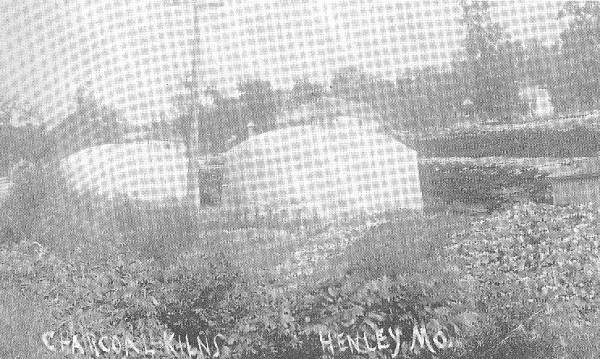
Charcoal Kilns in the early 1900's
I have no way of knowing who built the second store across the street from the store that William Reavis built, unless it was a man named Ivens. A. Ramsey, Joe Topping, and E. George Ernest ran the store in different years. Later Otto Bruce bought the store and ran it for several years. His widow, Helen Bruce, closed it in 1979 or 1890. It now stands empty.

Customers teams and wagons in the Stockyard Run by Kearney Smith
William Reavis built the first store in Henley. Jim Jones and Mathias Max Goetz also ran it. Gus Thomas and his brother Andy Thomas bought it in 1911. At Andy’s death, Gus Thomas and his wife, Ethel Thomas, ran the store. After Gus Thomas passed away, Ethel ran it for several years; all total they ran the store 56 years, 1911-1967. It was a general merchandise store. When you say “General” it meant just that. They carried anything you ever could use at that time; clothing, shoes, hardware, harnesses; well buckets, nuts, bolts of dry goods by the yard; fences of all kind and furnished dynamite, black powder and caps of which the tiff mine used. After Ethel Thomas gave up the store, it stayed idle for a year or more. Bill Sloan and wife bought and ran it for a year or more. In July of 1970, Jack and I took it over and ran it from 1970 to 1978. After that, several ran the store but it now stands empty. Glen Williams now owns it.
When Gus Thomas had the store Jack’s mother and dad ran the creamery. Jack kept pestering his mother for a little red wagon he had seen at the store. As his mother was busy, and to get rid of him, she scribbled on a blank check and gave it to him. He was six years old. He took the check over to the Thomas store. Gus filled out the check and Jack came dragging his little red wagon home. His mother never gave him another blank check.

Reavis's store in the 1970's, when author and her husband ran it
Burdette Jones built the restaurant that stood next to Reavis’ garage, in 1902. He ran it for a time. Then, at different times Richard Miller, Frank Wilson, and Perry Buster ran the restaurant. Willard McFall bought it from Perry Buster in September of 1923, and ran it until March of 1929. Jim Jones took it over and ran it until it closed. Jim made his own mustard. You could never find any mustard that beat his home made mustard. Jim Jones built a two story house just below the railroad tracks, which was the first saloon in Henley I have been told. After a while he quit the saloon business and made his home in the building.
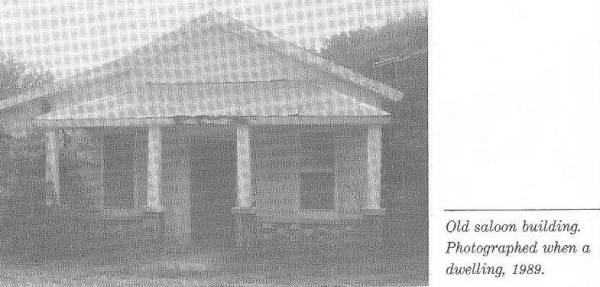
Old saloon building. Photographed when a dwelling - 1989

Old Restaurant in Henley - Early 1940's
To the best of my knowledge the old cement block saloon building just down the street from Jim Jones was built by Frank Loethan and Jim Evers, also the house next to it on the right. Pete and Ben Loethen ran the saloon, also Ben Jones and Charlie Jones. After the saloon went out it was used as a dwelling house.
Gus built an elevator across the street from Iven’s store. The elevator burned down and another was built. M.F.A. Exchange took it over. Lief Ingram, Doc Jones, Charlie Doerhoff, and Frank Miller are some of the people that ran the Exchange. There were probably more.

Saloon run by Ben Loenthan - Pictured are Pete Loethan and sister
By the side of the Exchange on the left was a loading platform where gravel and tiff was loaded into a boxcar for shipment by the Rock Island Railroad. Some of the tiff was shipped to Coffeyville, Kansas, and other places. On the right of the Exchange was another platform where gravel was loaded.
Joe Klug built a cement block house just below, south of the Rock Island Railroad. He ran a blacksmith shop beside the house. There was also a blacksmith shop this side of the creek bank. Several ran it. I do know a man named Love ran it, maybe the last one to run it. Charlie Evers also ran a blacksmith shop in Kempker’s garage at one time. Raymond Schulte ran a charcoal kiln a little ways from Henley.
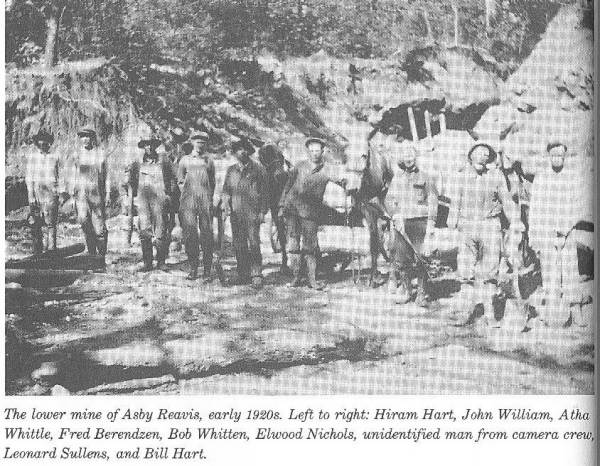
Lower Mine of Asby Reavis - Early 1920's
There were two tiff mines located approximately three miles west of Henley. They were owned separately by Osby Reavis and Walter Steenbergan. Osby Reavis’s mine was called The Old Shot Mine. Starting the mines, the men took the dirt out with mule and carts; and later went to Model T Ford trucks, the dirt and tiff were taken out by hoist and cable car. The water was pumped out of the mines by one cylinder gas engines and Fordson tractors. Osby Reavis ran the crusher and jig with two Fordson tractors.

Upper Tiff Mine in the 1930's
When Atha Whittle, Jack’s dad, and Gordon Wildom took over in the middle 1930’s, they pumped the water out with an old jumbo steam engine. Joe Golden was the man that fired the engine to pump the water out. Clarence Belt also fired the engines. The engines pumped day and night. They used an old Titian tractor after the water was pumped out ot keep it pumped dry. This old Titian tractor and a Model T truck were left in the mine until years later some company got them out. After the old jumbo steam engine blew up it was replaced with a Nickleson Harrison steam engine and the last tractor to be used was a Katjornerman twin cylinder tractor.
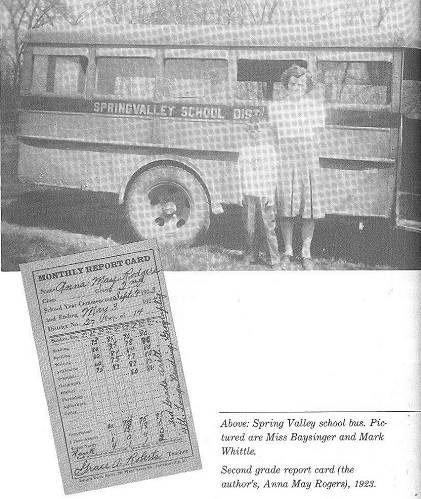
Spring Valley School Bus -Miss Baysinger and Mark Whittle
and
Second Grade Report Card for Ana May Rogers - 1932
The first school located approximately half a mile north of Henley burned; so a new school was built half a mile to the east on the road what is now route BB.
From this Spring Valley School, I walked two miles to school each day. We carried our lunch in a half gallon syrup bucket. The school was a two room building.
The first school was built about 1882 so I have been told. Then they built the Spring Valley School on Route H in the late 1920’s or early 1940’s. W.P.A. workers built the new building. In 1954 the Spring Valley School was consolidated in Eugene, Missouri. The building is now Spring Valley Church.

Above - Spring Valley Baptist Church - 1930's
Below - Methodist Church in Henley - 1900's
There were two churches, Baptist and Methodist. The Methodist Church was built up the street between the two stores on a hill. I understand both were built in 1882. The Methodist didn’t have enough support to keep it going, and it was turned into a dwelling house.
The First Baptist Church was a small log cabin built just above the spring but across the road on the hill. Then the Spring Valley Church was built in 1868 just a short distance from the Henley Lake, and downhill from the first church. It burned. They moved to Spring Valley School on Route H. It now has a large attendance.
Some of the teachers that taught Spring Valley School were: Ida Agnew; Mrs. Simpson; Reverend Barnard; Earnest and Myrna Jones Leslie; Myrtle Hawkins; Pearl Taggart; Imogene Baysinger; Mary Jones; Dorothy Lansdown; Miss Silfa; Barcie Steelbergan; Hale and Ellen Bunker Henley; and maybe more.
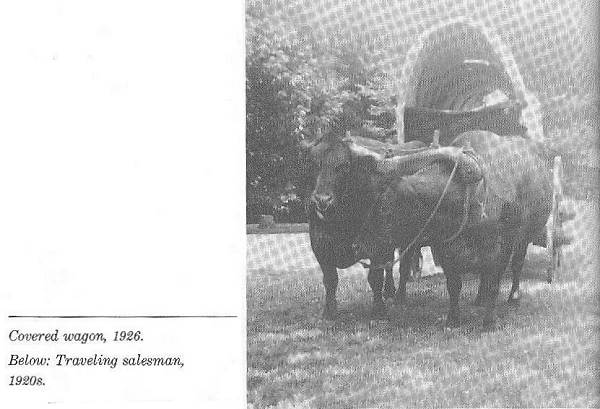
Covered Wagon - 1926

Traveling Salesman - 1920's
Back in 1920 and 1930 tent shows came to Henley. Gypsy tribes came each year, traveling shows, wagons driven by oxen. Picnics were held at Walnut Grove on William Henley’s farms. There were Chautauquas with actors, musicians and entertainment of all kinds. Brush arbor meetings, Croquet, horseshoes and ball games were a part of the recreation for the young people. They had music parties where several musicians would gather at first one house then another. Uncle Jim Henley’s home was a very popular place to gather. Aunt Cora Henley played the piano, my grandfather Leonard Sullens played the accordion, Elton Craig was on violin, and Fritz Hager on guitar.
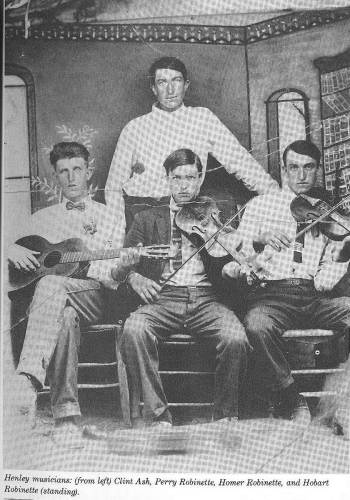
Henley Musicians - Clint Ash, Perry Robinette, Homer Robinette and Hobart Robinette - Standing
There were several guitar and violin players around so they never ran out of musicians.
I could be another three years on this history and would never find all of the possible narratives of our town of Henley.
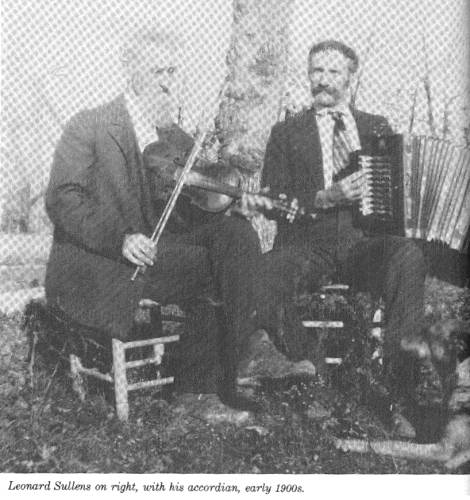
Leonard Sullens on right - Early 1900's
Leonard Sullen’s “My Dream Waltz” is Number 6 on the list of my grandfather’s tunes. The origin of this tune is as follows:
Leonard Sullens was experiencing a high fever with the flu. The melody kept running through his mind, over and over until he got out of bed and played the tune on his accordion. He named it “My Dream Waltz.” I have this accordion that he played so many times at schools, churches and music parties. He taught me to play it. Once in a church in Pisgah, Illinois, we had a May Day program, and I played “In the Sweet By and By.” I was only nine years old, but I surely felt proud, and of course, scared to be up in front of all the people.
Leonard Sullens played over the W.O.S. radio station in 1924 which is now K.W.O.S. station, Jefferson City, Missouri (I still have cablegrams, cards and telegrams from all over the United States).
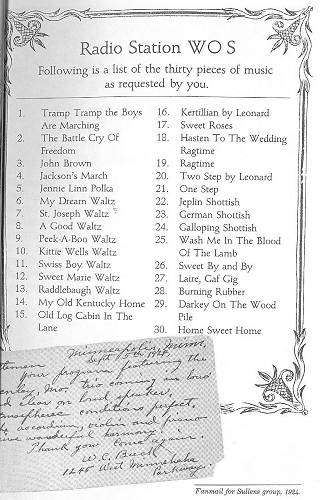
Radio Station WOS Song List
Click image for larger view
Radio Station W.O.S.
Leonard Sullen’s Request List of Songs:
- Tramp Tramp the Boys Are Marching On
- The Battle Cry of Freedom
- John Brown
- Jackson’s March
- Jennie Linn Polka
- My Dream Waltz
- St. Joseph Walt
- A Good Waltz
- Peek a Boo Waltz
- Kittie Wells Waltz
- Swiss Boy Waltz
- Sweet Marie Waltz
- Raddlebaugh Waltz
- Old Log Cabin In the Lane
- Kertillian by Leonard
- Sweet Roses
- Hasten To The Wedding Ragtime
- Ragtime
- Ragtime
- Two Step by Leonard
- One Step
- Jeplin Shottish
- German Shottish
- Galloping Shottish
- Wash Me In The Blood Of The Lamb
- Sweet By and By
- Laire, Gaf Gig
- Burning Rubber
- Darkey On The Wood Pile
- Home Sweet Home

Buggy in early 1920's
Now I will explain what a Brush Arbor meeting was. It was a gathering of people to hear a sermon, preached by first one then another. Poles were driven then covered with brush out in an open field. George Hodge and Brother Brady were two we knew of who preached. One was held on BB then a gravel road, one on Joe Kroeger’s place. Buggies and wagons were the only transportation back in the 1800’s and early 1900’s, or by horseback until the automobiles came in. My granddad and grandma and I, driving in a buggy drawn by two mules, would drive ten miles to church on Sundays.
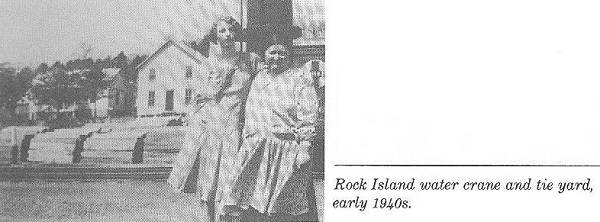
Rock Island Water Crane and Tie Yard - Early 1940's

Excursion Train at Henley Depot
Click image for larger view
There were two hitch rails to tie their horses; one just across the street in front of Reavis store, the other close to the elevator. On Saturday the street would be lined with buggies and wagons to sell eggs, butter, chickens and so forth.
My granddad, as well as others, hauled ties for the railroad. The source of income was from farming, mining, and timberwork, such as hauling ties and mining props for the railroad. You can see on one picture the stack of ties for the railroad, beside the water crane. The trains picked up and delivered mail and all the freight was picked up by train. Kempker and Reavis would go to St. Louis or Kansas City and buy their automobiles; the “local” would bring them to Henley. Excursion trains would bring people from St. Louis and Kansas City to Henley, as you can see from the picture.

Fisheman's Paradise - Henley Lake
George Carney and Asby Reavis made Fisherman’s Paradise Lake into a resort area in the early 1900’s with cabins built all around it. There was a boat house, bath house and a restaurant where you could buy almost anything. Preston Jenkins took care of the boathouse and I have been told Jack Kurtz either took care of the cabins or the restaurant, but we do know Boyd and Essie Reavis ran it until it closed. The building was brought to Henley remodeled with additions and made into a dwelling house. Hector and Zetta Hickey lived in the house. Henley also had a jail but just a few were ever locked up. I heard that a woman was one of them.
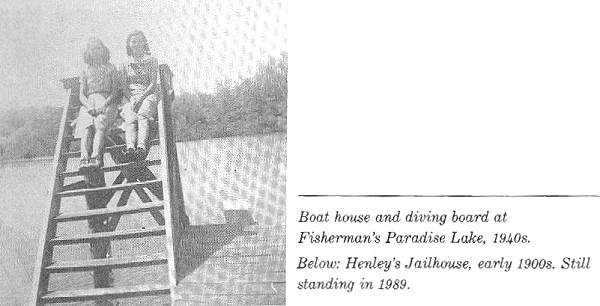
Boat House and Diving Board at Henley Lake - 1940's
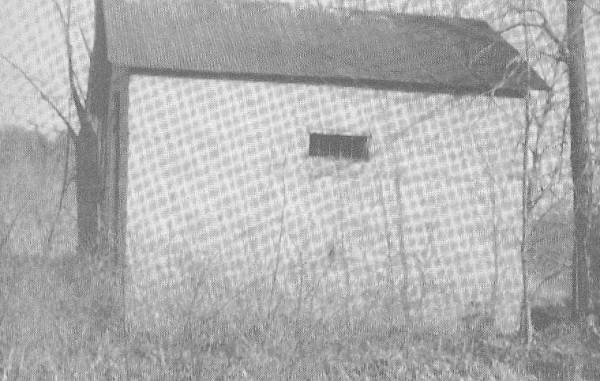
Henley Jail - Early 1900's
Atha Whittle ran a jitney service in 1923-24. Jitney is what they call a taxi cab.
Henley was incorporated in 1911. Frank Kempker was made Mayor, Otto Bruce, Clerk, Hansford Burks, City Marshall and wearing a tin badge; Peter Hoskins was Henley’s first sheriff. Ivy Jones was also Sheriff in the early 1900’s.
In 1871, near Turner’s Mill on Bois Brule Creek, the Sulphate of Barite deposits had been developed and a stamp mill operated there, the product finding a ready sale.
About a mile down east a railroad bridge was built over the Osage River at the same time the Rock Island Railroad was built.
In 1819 the first steamboat steamed up the river.
From then on steamboats ran the Osage River. Jim and Mary Russell lived about a quarter mile from the Osage River on a gravel road, which is now known as Teal Bottom. They could hear the steamboats as they made their journeys up and down the Osage River. Finis and Tom Russell were sons of Jim and Mary Russell. Tom Russell lived to be 102 years old. Finis and Berth Russell were the parents of Earl Russell and lived in the Mark Belshe house in Henley.
Melitta and Minnie Honacher lived in tents as others did before and after the railroad was built. They also lived in Joe Klug’s house in 1952. It is now torn down. Four of their daughters still live in Henley: Flossie Emmerich, Pearl Emmerich, Irene Russell, and Fern Sloan.
A little ways down east of Finis Russell’s on Teal Bottom Road is a natural bridge and cave on an Osage River bluff. After centuries of time, Mother Nature carved a natural bridge of rock. The water running through the rocks enlarged it year after year until the natural bridge of rock was formed. The bridge is 12 or 15 feet high and that many feet wide. You could drive a care over it if not for the trees and shrubbery on the rock bridge. Up a piece is a bluff where you enter a cave. A ways back inside the cave water dripping down formed what was always called a Devil’s Churn. On farther you entered a large room.
To the east of the natural bridge is a large bluff they call Dover’s Bluff. Years and years ago a man by the name of Dover built a house on the bluff and that is why it is called Dover’s bluff.
A National Prohibition Act called Volstead Act went into effect January 16, 1920. On December 5, 1933, after years of being dry the country became wet again. While prohibition was on there were several whiskey distilleries dotting the woods where you could buy whiskey for $1.00 a gallon.
In1960 there was a train derailment, half a dozen or more box cars were derailed, about one half mile east of Henley. There were shoes in one car and canning lids in another. I don’t know what the other cars held; it was quite a scary sight to see…the rails bent, rails up rooted, twisted metal in the wreckage.
Four families moved in when the Blue Oak Handle factory came in. Two names of the four were Beard and Smith. The factory came from Eldon, Iowa.
Lorain “Dumb” Reavis built the two story cement block house at the foot of the hill across from the natural spring I have mentioned before. The house was built in the early 1900’s. Martin Loethen was one man that helped build the house. The concrete blocks were made on the site; the spring still furnishes water to the house. Dorothy and Margueritt Jones now live there. It is still a beautiful old house. William Henley, when plotting the town, named one street after his daughter Minnie Henley. The street, south below the railroad tracks where the old saloon building is, was named Minnie Street. She married Burdette Jones, son of Washington Jones, a brother to Henry, Asby and Ivy Jones.
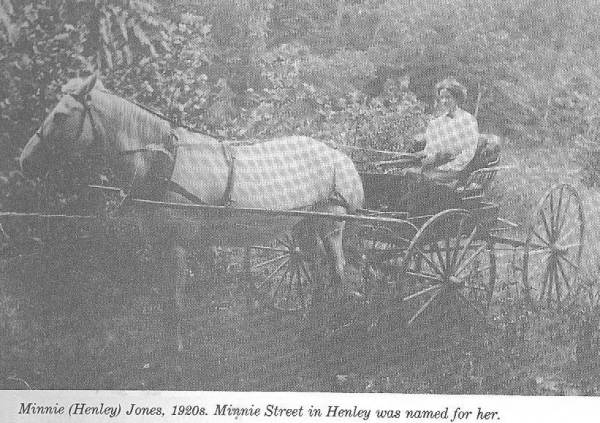
Minnie Jones - 1920's
There were four men we remember that fished and sold fish. George Wilson had a houseboat that he lived in and sold fish for a living on the Osage River. On the Osage River when the flood of 1926 came, he left his houseboat and moved to Henley. I learned that the houseboat was brought ashore and made into a cabin on the Osage River by the ferry. George Wilson passed away in 1938 or 1939. The others were Ed Fuller, Frank “Humpy” Paul, and Frank Sweeney.
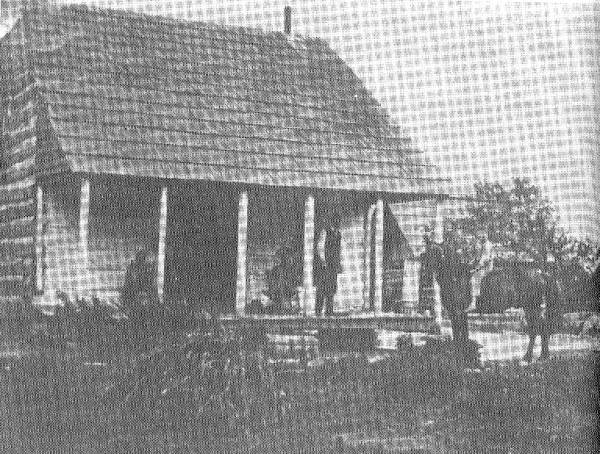
Henley area Log House
At one time there was an old time fiddler, Charlie Kingrey, who lived in a big hole, really a small cave, half a mile down toward the Osage River.
Henley has been flooded by the Osage River several times. The great flood was June of 1844. It was far the worst. The one flood in Henley I can sure remember was in 1943. We lived in the old saloon building at that time. The back water from the Osage was rising so fast, Jack left for work in the morning and when he came home from work the water was up over the front door. Bob Loethen lived in the two story building beside the saloon. He rowed a boat to the second story window to get in his house.
In the 1800’s and 1900’s a lot of houses were made out of logs. Some had two rooms with a loft above where the children slept. There were large families in houses like these when I was 4 years and older. I can remember my grandfather lived in a two room log house. The logs between the rooms were open. Later, he boarded it in and put weather boarding on the outside, and added another room. He had two porches on it and that new room he added was where I was born, or route BB now.
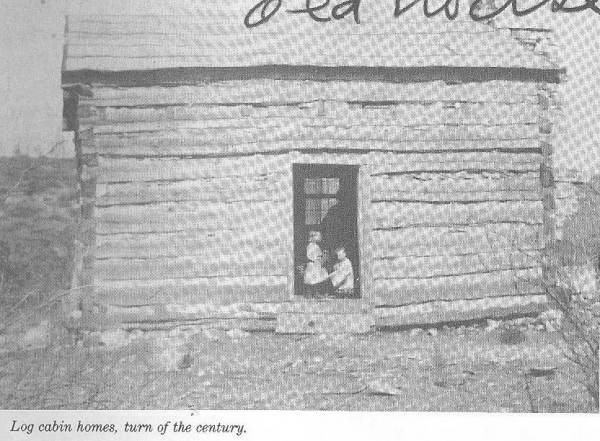
Another old Henley area Log House
Jack was born in a two room log house just a few yards back of the “Dump” Reavis house. We found out that Royal Miller was also born in the same house.
North of Henley just a short distance up on the hill, Troy Robinette lived in a log cabin and started his family. Bill Golden also lived and partly raised his six children in a log house.
Henley had a doctor in the early 1940’s. Dr. Omar Hickey was our doctor for several years. He had his office in the old bank building. Dr. Hickey was the son of Alex Hickey. Alex was a brother to Edward Hickey, Orlando Hickey, Hector “Red” Hickey, and to a sister, Ina Robinette. They lived upstairs in the bank building.
After Dr. Hickey left, Asby Jones had a drug store there for a while. Alen and Ina Robinette lived in the upstairs. She had a beauty salon upstairs and Alen ran a bar downstairs. Since then the building has remained vacant.
Gus Thomas’s and Otto Bruce’s stores had pot bellied stoves where people would gather to visit. One can imagine the fish tales that were told around those stoves.
At the Marys Home, Eugene and William Reavis’ store in Henley, all the stoves were built almost identical inside of the stores.
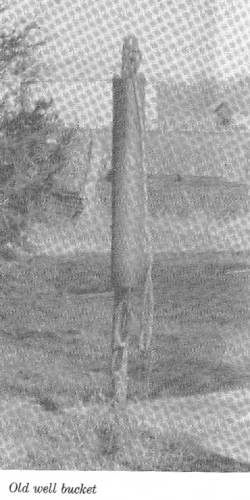
Old Well Bucket
In the old times in the 1800’s and before, water was carried from a spring in a gourd; then they had wooden buckets. I can remember drinking from a wooden bucket at Granddad’s. Then there were granite ware, porcelain and aluminum buckets, and a tin dipper was used to drink from.
The first wells were dug by hand, lined with rock. The water was drawn with a bucket and rope. Some had hand cranked winches to draw their water with. Later, long galvanized well buckets were lowered by a pulley and rope.
Usually, on Saturday Henley would be lined with wagons and buggies. Familes came to sell their produce; a few dozen eggs, cream and butter would buy their week’s supply of whatever they needed. Ten cents would buy a pound of salt. Sugar, baking powder, coffee, kerosene and lye is about all they would need for they raised their vegetables. They had cows for milk and butter, had their own meat, hogs and cattle, raised cane for molasses…so their needs were few.
Holes were dug in the ground, lined with straw, then filled with turnips, cabbage, apples and potatoes, and covered for their winter use. If they didn’t have a cellar, cellars were dug for that purpose, and also a haven of safety when storms hit. An axe and a kerosene lantern were always kept in the cellar, the axe in case something fell against the cellar door. The first cans for canning were tin and were sealed with wax. Wheat and rye were ground for flour, corn for corn meal. The mill was a busy place on Saturdays. While the men were at the mill the women would be at the General Store buying dry goods, thread and so forth. Crackers and pickles came in barrels.
Sugar, salt, coffee, and beans came in sacks to the store, and were emptied into bins in the store to be sold in any amount you wanted. The merchant would grind coffee for you or you could take it with you to grind at home. I have ground coffee on a hand grinder for my grandmother and also for my mother. I had my grandmother’s old crock churn with a wooden dasher that churned cream for butter. I creamed butter time after time in this old churn. The rich cream was put in the churn, then the dasher went up and down until the butter separated. The butter mild would be speckled with bits of butter after cooling it, and it was a delicious drink.
Kraut was made by rubbing the cabbage over a kraut cutter until shredded, then put into ten or twenty gallon crock jars, salt added. Covered to ferment, the brine had to be dipped off the top until fermented.
Dried apples and peaches were a delicacy. The fruit was washed, sliced and spread on a white cloth, put in the sun to dry. They made tasty fried pies.
Lard was made from hog fat, cut into small pieces and put into a large iron kettle to be rendered into grease. It was cooked over a slow fire, put into tin buckets, and stored.
Old grease was saved through the winter, placed in a wooden hopper, water was poured over the ashes which became lye as the water passed through the ashes. Grease was put with the lye into a large iron kettle, placed over a slow fire, stirred constantly until it reached a certain texture, then poured into containers to harden; then it was cut into bars.
Grandma had white soap as well as yellow. I have helped her stir it while cooking with a large wooden ladle.
Washing clothes was always a chore, for you had to scrub the clothes on a tin or glass washboard, up and down, until they were clean. I washed this way until my second son was just a baby. We got an old Maytag washer run by a small gasoline engine.
Ironing was with cast iron. They were called sad irons.
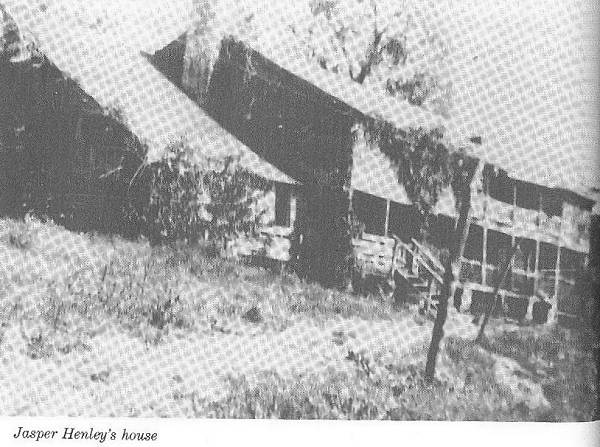
Home of Jasper Henley
These irons were heated on a wood stove. Later they came out with irons with handles that lifted off. Those old irons were also used to warm feet on the cold nights in winter, wrapped with a heavy cloth.
Kerosene lamps were used at night for light. I was raised with such lamps. When the gas lantern and Aladdin lamps came out, that was a luxury.
Wood and coal stoves were used for heating. Meals were cooked on a wood range. The food was cooked in cast iron kettles before the stoves came out. The iron kettles were hung in a fireplace to cook a meal. Food cooked in those old iron kettles surpassed the new modern cookware in taste.
The Henley cemetery was laid out for slaves to be buried in. It was laid off for that purpose in the early 1800’s. They buried the slaves over six feet deep, so others could be buried over them. Just how many slaves were buried is not known, but as one grave was being dug they sometimes dug into another slave grave. The graveyard was deeded to the Spring Valley Church by John Henley. That is how Henley Cemetery got its name. He built the house below the cemetery, what we know as the Evert Martin house. John Henley is buried in Henley Cemetery.
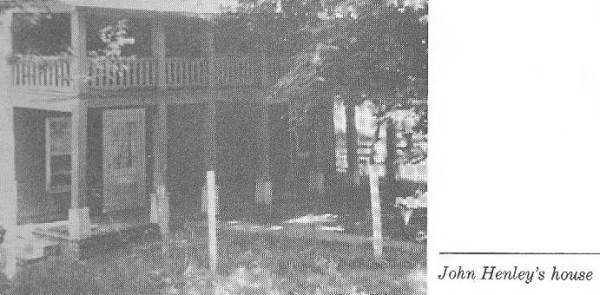
John Henley Home
Jasper Henley built the house on Bois Brule Creek. William Henley built in Henley; all three brothers kept slaves. All three houses (including father John’s) have been torn down.
I have been told at one time seven of the Henley’s clan had slaves close around here. There is an Indian language tree on the Allen Kiral farm. The bent tree is pointed direct to a cave with a spring coming out of it. This cave is on the Billy Smith farm.
A stage coach relay station was at Hickory Hill about five miles from Henley. The location is at Clarks Fork on the old Leonard Jones’ farm.
Christopher Sappenfield drove the stage in 1865. The stagecoach ran from Hickory Hill to Sedalia, Missouri.
The road from Henley to Brazito, Route H, was a gravel road. It was widened, some curves were cut off, and a new bridge was built over the Bois Brule Creek in 1949. It was black topped in 1957.
On the left side of the old exchange that burned was a tin building painted black. They called it The Old Black House. To the best of the information I have, it was where the first post office was located in this building, just across the street from where the post office is now. Later, John Warsback had a barber shop in the tin building. There, Jack had his first haircut by John Warsback in this building. There were several barbers in different places and different times. I have learned a few:
Jack Kurtz, Glenn Wyrick and Irley Templeton barbered in the side room of Toppin or Bruce’s store at different times; also Kenneth Robinson had one in Mark Belshe’s garage.
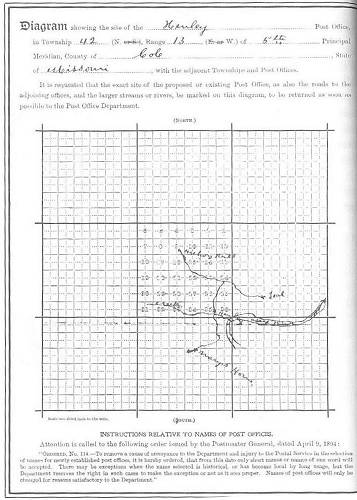
Proposed Site of Henley Post Office
Click image for larger view
The first postmaster was William L. Reavis, February 12, 1902; next were William D. Norfleet in 1907; George F. Ernest in 1909; Hansford C. Burks in 1912; Peter N. Hoskins in 1933; William H. Hickey in 1944 (this was Hector Hickey, nick named “Red”); Aubrey D. Scott, 1968; Mrs. Betty J. Ford, 1976; and Adolph L. Lepper in 1983. Fred C. Evers is our Postmaster now.
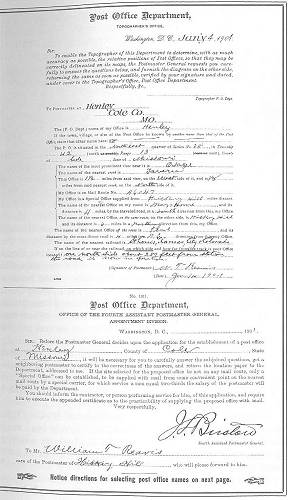
Post Office Regulation
Click image for larger view
There are several caves in Cole and Miller Counties. The largest is on the Big Tavern Creek, on the bluff near its confluence with the Osage River. The entrance is about 25 feet square and is situated 30 or 40 feet above the water in a solid limestone bluff. The stalactite formations are of strange and fantastic appearance, some of the looking like huge images of marble. The whole effect by torch or lantern light is weird and eerie. During the Civil War one of the caves was used as a retreat by the bandit Crabtree.
During the Civil War, a squad of militia was camped on Curtman Island on the Osage River. In 1864 they were surprised by the guerrilla Crabtree. Seven men wee butchered by him and his men: Yancy Roark, F.B. Long, Nathaniel Hicks, Richard Crisp, S. McClure, W. Gibson and John Starling; undoubtedly the Crabtree outlaw had been hiding in two caves. This information was told to me by the grandson of Adolph Loethen. Crabtree was killed in Goonsfield, about three or four miles away on Teal Bottom road, east of Henley, toward the Osage River. He was shot in an old barn in the field by Adolph Loethen, and died in what is called the Crabtree Cave, about one half mile from where he was shot. He crawled or his men helped him to the cave, where he was found dead. This cave is approximately one mile from Curtman Island on the north side of the Osage River. I hear it was called Goose Island, now owned by Leonard Kempker and sons. This Crabtree had terrorized the entire central part of Cole County, stealing anything he could use, burning buildings and fields. Crabtree, when found dead, was loaded in a wagon by Judge Smith, Thomas H. “Turkey Bill” Hoskins and Willard Hoskins. He was buried close to the old Teal schoolhouse. Later he was dug up and taken to Hickory Hill. I assume this was in the old Bethel Cemetery.
In 1860 a log church was built northeast of Hickory Hill, which now lies between Old Route 54 and the county road near the Curtis Bush home. Daniel Green, a Kentuckian, was the first minister. Crabtree was buried in Herman Scheuler’s wedding suit.
I have no way of knowing if this Crabtree was a deserter or not, but in Company B., Clark Township, Southern Guards, Crabtree and five others were listed as “desertion.”
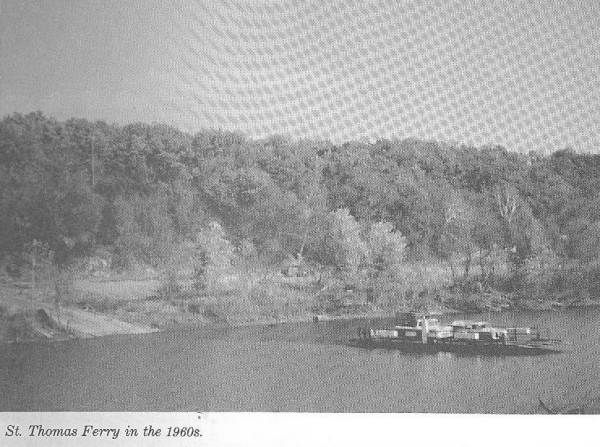
St. Thomas Ferry - 1960's
Seven miles east of Henley on the Osage River, Adolph Loethan and his step brother, Herman Scheuler, built a small ferry boat in 1853, just large enough to hold one wagon and team of horses to cross the Osage River. They had to ease the ferry across the river by poles; later, wire was strung across the river to guide the ferry across the river. Adolph Loethan ran the ferry until his son, Anton Loethan, took it over in the 1890’s.
George and John Norff put in a second ferry about a hundred yards down stream from the Loethan Ferry Landing. Loethan’s ferry shut down in the late 1930’s. John Norff ran his ferry until the late 1940’s. One of the ferries was called Scheuler’s Ferry. St. Thomas ferry began in the early 1860’s and closed on August 29, 1966, when the bridge was erected crossing the Osage River. Farther downstream from the Scheuler Ferry was a steamboat landing where White Oak Creek runs into the Osage River. Farmers loaded grain and other products on the boats to be taken to market. There was a large house used as an Inn for travelers to spend the night.
Where Bois Brule Creek runs into the Osage River is an island they called Bloody Island.

Former Trading Post and Fort on Osage River
Also, on White Oak Creek was a post office called Old Teal. It was on Guy Henley’s farm. In 1929, Ira Henley ran the post office. Bertha and Jim Jacobs ran the Inn. At the time, there was a post office at Hickory Hill, Mary’s Home, Brazito, and Old Bass.
In 1840 on section 35-4, range 12, on the Osage River, the government deeded land to Margaret Scheuler. On this land is an old brick two story building. I have been told it was a trading post. It has open holes all around the sides of it, in what looks like peep holes for rifles to fire from. It faces the Osage River and some think it could have been a fort when built. If one could only find out, there is a world of history behind that building.
The slaves of Jasper Henley built his house, the house we now call the George Fisher house, on the Brois Brule Creek. There was a cabin on the left side of the house as you can see on the picture. This is where the slaves cooked the meals. It was called the cook house. This cabin was moved to the Clarence Belt’s farm on a gravel road about six miles from Henley. The road is now Route H, the farm now owned by Allen Kiral. This log cabin is a century or more years old. The cabin served as a home for Clarence Belt’s family who moved into it in 1919. He raised six children in this cabin. When the seventh son was born, they built onto the cabin.
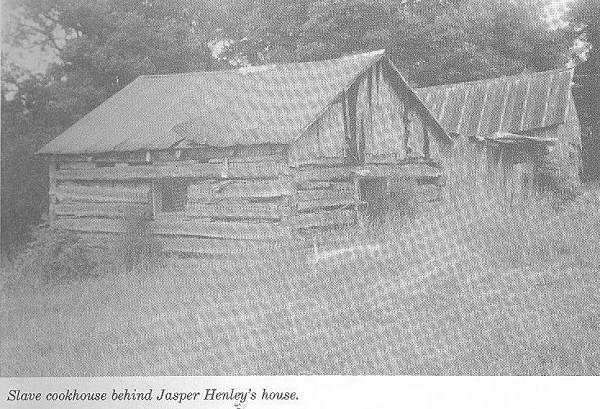
Slave Cookhouse behind Jasper Henley's House
Ben and Mary Loethen, who built the old cement rock saloon, raised eleven children, three boys and eight girls: Martin, Peter, John, Nellie, Katie, Tresa, Lizza, Sloma, Lena, Regina, and Matilita. All eleven children lived to be in the late eighties. Martin was ninety six years old when he passed away. Matilita is the only survivor. That is very unusual.
There was a tie draw near Hoeker, on the Osage River, where they pulled ties out of the River, as they were rafted down. Along in this vicinity was what they called a gravel spur where gravel was pumped from the River for the Rock Island Railroad.
In 1902 and until the automobiles came out, the only way the mail was carried was by horseback, and horse and buggy or wagons. At one time there were two routes out of Henley. Olin Belshe carried the mail from 1912 to 1934. He was the first to carry it in a car, a Model T Ford. Even then he would have to go back to a horse and buggy at times for the roads where he could not drive a car. Warren Smith was also one who carried mail on horseback. In later years they made the routes into one route. Gene Kiral is our mail carrier in Henley now. I have been told Jass Corrender brought mail to Hickory Hill. Shelby Fowler delivered mail from Hickory Hill with a mail hack driven by mules.
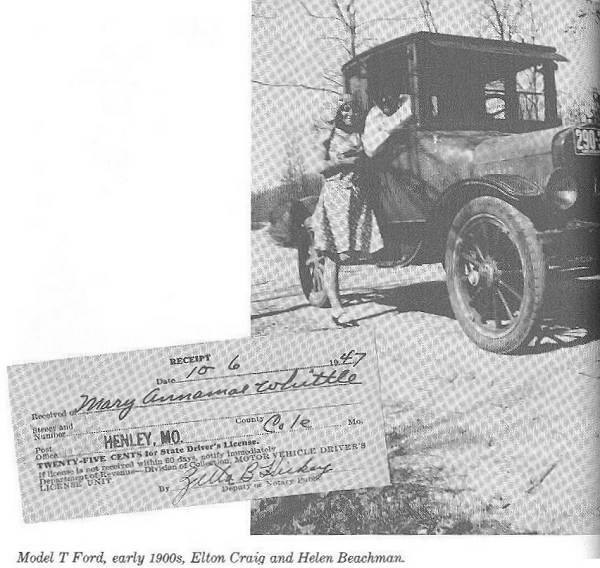
Model T Ford, early 1900's - Elton Craig and Helen Beachman
Back in 1947 driving licenses were issued for twenty five cents.
I have mentioned Brush Arbor meetings before. They were also held at Roy Jester’s house. At that time he lived right next to where we now live. The preachers rode horseback carrying a Bible, and were called circuit riders. They would preach first one place and another.
There was a filling station in the early 1940’s at the corner of route BB and route H on the land now owned by Spring Valley Church. At the time 54 highway was being built, as they detoured the traffic down through here, Warren Robinette ran the station. It wasn’t open too many months.
During World War II almost everything was rationed: sugar, coffee, hose, fuel oil and gas. No matter how much money you had, it was not to be bought without war ration stamps. It was hard times for the one who had quite a distance to drive to work.

WWII Ration Stamps

Author's House in Henley
Leonard Preston Jenkins, an old timer, married Doshia Farley, August 13, 1885. They lived on a farm near Mary’s Home for several years, moved to Henley when the railroads were being built in 1889 and 1900’s, passed away December 1, 1942. They were the parents of thirteen children. Preston Jenkins’ father was Jonus Anderson Jenkins. He passed away April 23, 1892. He was a Baptist minister and spent all his life in the Mary’s Home area. He preached in a log cabin church in Mary’s Home. This information was given to me by Elsie Wyrick, one of the daughters of Preston Jenkins.
Judge Henry Marion Smith, Presiding Judge of the Cole County Court, was born in Clark Township, Cole County, on a farm near Hickory Hill on June 23, 1848. There he was raised and educated in the neighboring schools. His parents were Henry and Elizabeth Smith who came to Missouri from Kentucky at an early date. Judge Smith had the misfortune to lose his father when he was ten years of age. At the age of twenty two he bought a farm three miles east of his mother’s home, which he conducted with success seven years. He sold this farm and purchased a farm near Henley. He was a successful farmer, dealing largely in livestock. He was married January 16, 1870 to Mary J. Reavis, daughter of Willliam Reavis, a farmer of Cole County. The children born to this union were: James Kearney Smith, Laura Smith, Leonard Smith, Arthur Smith, and Willie Smith. He was elected Presiding Judge of Cole County. Judge Henry Marion Smith was father of Kearney Smith, grandfather of Jasper Smith and great grandfather of Virgil Smith.
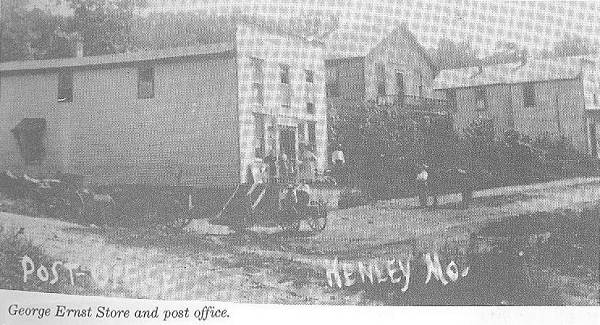
George Ernst Store and Post Office
Thomas Benton Hoskins settled here in the early 1800’s. He and his descendants have made molasses for a century. It has been made on the same farm, same spot of land by a spring fed creek, and been known by Molasses Mill, and has never been out of the Hoskins name, since settled from the government. Earl Hoskins Sr. was the last one to make molasses which was discontinued in the early 1950’s.
His children started making molasses again in1981 and have been making molasses yearly since. They wanted to keep the old crafts, and believe that the older generations today’s living link to a past way of life that should not be lost to modern technology. Molasses was a staple part of cooking in the past, serving as a sweetener, also dessert. Wilburn Hoskins wrote: “One of my favorite dishes was to take molasses, stir it with butter, and spread it over hot biscuits. As they say, “it is finger licking good.”
The land where our house now stands was deeded to Peter Rose, April 15, 1857, from the government, then was deeded to Henley, May 1, 1857, then was deeded to William Reavis and Sons, December 10, 1907. We have no way of knowing just who built the house but assume that William Reavis built it. If so, our house would be over eighty years old.
Otto Bruce’s store earlier belonged George Ernst. At one time the post office was also in the store. From 1909 to 1912.
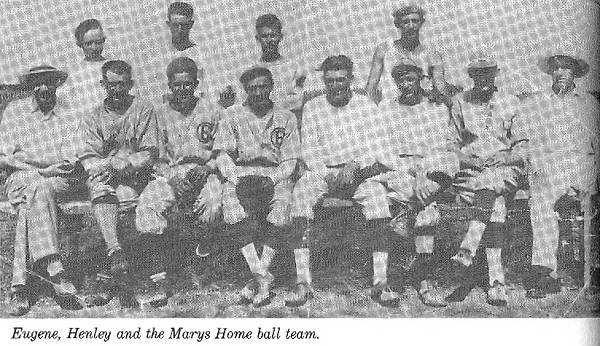
Eugene, Henley and Marys Home Ball Team
As you can see from the picture, the two story building on the right of the picture is the old switchboard and post office. The house in between was a one room house; a man by the name of Warsback lived in it. It was later torn down.
A room was built onto the right side of the store, and was used for a post office run by Hansford Burks. Later the post office was moved to the switchboard building and also ran by Hansford Burks. He was postmaster from January 12, 1912 to August 18, 1933.
Eugene had a ball team, as you can see in this picture called Independents. Some of the players were from Henley and Mary’s Home.
Back in the 1900’s and late 1800’s, the boys wore knee length pants called “knickers,” long socks, button slippers and shoes; the girls had bloomers reaching to the knee. Some were made from glossy sateen cloth. Long socks were worn with garters or knee length socks; and don’t let us forget the scratchy long handle underwear of wool that we detested so much, but they sure kept us warm. At bedtime on the long cold, winter nights, we were loaded down with home made quilts, a heated sad iron at our feet. If we stuck our heads out from under the covers our breast would form frost on the covers. The old wood stoves would burn you up on one side and freeze you on the other, but back then that is what we used for heat.
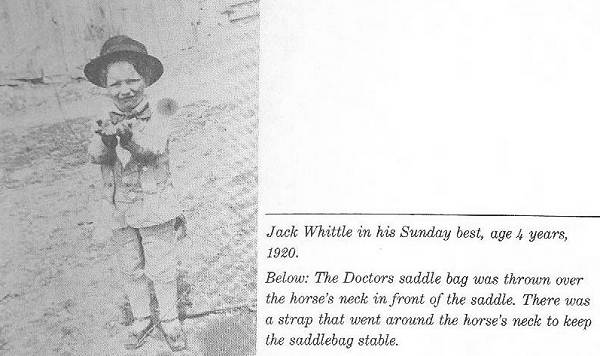
Jack Whittle
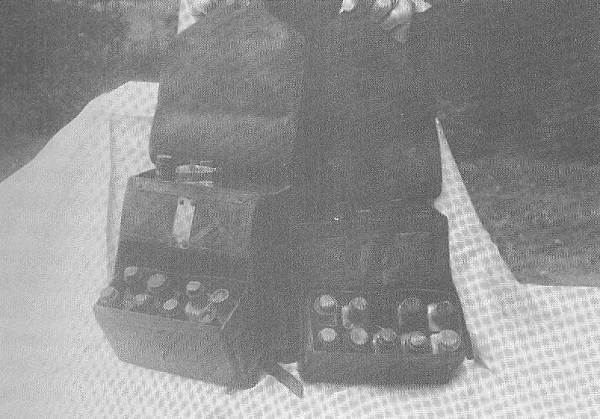
Doctor's Saddle Bag
As Henley doesn’t have any law protection of its own, it has a dependable Cole County Sheriff Department. The Cole County Sheriff is John C. Hemeyer. He was a deputy under Wyman Baysinger.
Back in the 1800’s and early 1900’s, doctors rode horseback or by horse and buggy to treat their patients. Even after the automobiles came, they had to go by horseback or buggy as the snowdrifts and muddy roads were so an automobile could not make it.
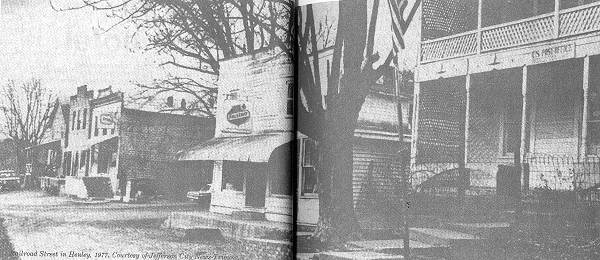
Railroad Street in Henley
The picture shows Railroad Street, the main street of Henley. The two stores were both in operation at that time, and the old Angenendt Hotel, to the right of the Post Office. The maintainer is being operated by Jack as he graded the dirt streets. The picture was taken on February 27, 1977 by the News Tribune, just before the street was blacktopped. The building by the store to the left of the street is the old bank building and also is empty.
I shall always regret that I never did take a picture of the old steam locomotive, for that is a lost area of history that will never return. One can only remember that era of history. The picture of the old steam locomotive can show that beauty was in the black iron monsters as they puffed their billowing smoke, and churning rods as they steamed up a grade. Their shrill whistles could be heard for miles, as we remember the old steam locomotives. We also remember the old folk song, “The Wreck of Old 97,” and the song, “The Rock Island Line.”
Part of this song is “I may be right, I may be wrong, you know you’re gonna miss me when I’m gone, on the Rock Island Line.”
It was the Rock Island Railroad coming through Henley that was the start of the prosperous town of Henley. The railroad served as transportation, mail and for freight shipped in and freight going out of Henley. Cream cans were shipped to St. Louis, also stock ties and mining props to be shipped.
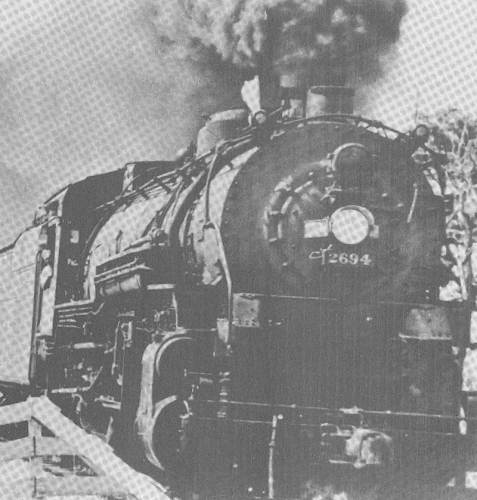
Rock Island Freight Engine
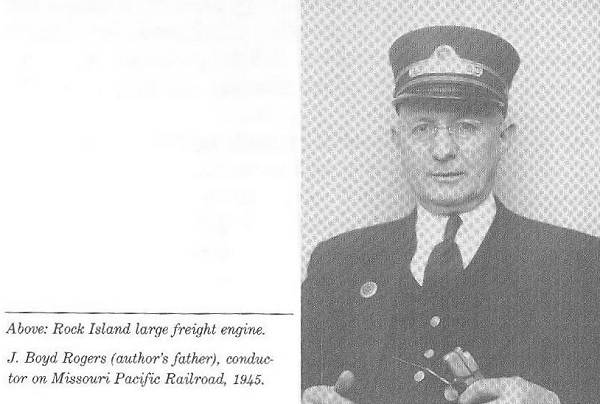
J. Boyd Rogers, Conductor on Missouri Pacific - 1945
I was fortunate in contacting an old engineer who was on the Rock Island Railroad from Kansas City to St. Louis. He was an engineer on the freight trains. Joe White was a fireman for twelve years, and engineer for eighteen years on the Rock Island before retirement. He is truly a railroad man for he has picture after picture of engines, switch engines and whole trains lining the wall of one room in his house. He is the Good Samaritan who loaned me the pictures of the old steam locomotives, for without the Rock Island train pictures, this history of Henley would not be complete.
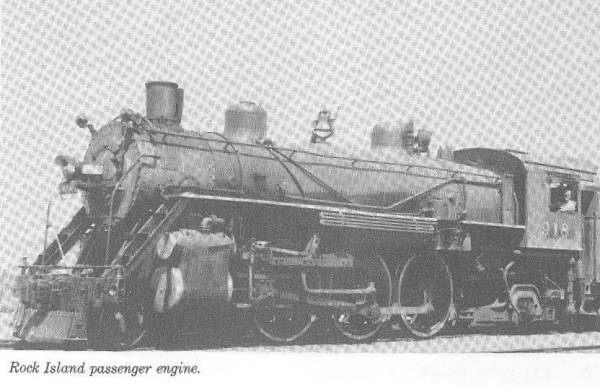
Rock Island Passenger Engine
The Engine 918 was one of the engines that pulled the passenger trains. It was called a “Pacific” engine. As I have said before, the passengers (trains) met here at Henley, at noon and midnight. The big engines pulled the freight trains, as high as a hundred or more cars. At times when the freight train was heavily loaded going up the grade to Eugene, the wheels would start spinning and they had to uncouple half of the train, take part of the train to Eugene, then the engine had to back down to get the other half of the freight cars and the caboose.
The large freight engines were called “Mikado” engines. This picture of a large freight engine pulling a long line of cars, the smoke boiling, shows a Mikado engine. Sometimes when they had a hundred or more cars all heavily loaded, they used two engines to pull the train.
My father, J.B. Rogers, was a conductor on the Missouri Pacific Railroad for years. One day, during the time we ran the General Store, I heard a commotion on the tracks. I looked out the window and saw a lone boxcar rolling down the tracks from the west! I called the railway company. They were so surprised the boxcar had not derailed. The boxcar broke loose at Eugene. As it is down grade all the way from Eugene, it had picked up speed and stopped in the middle of the Osage River bridge.
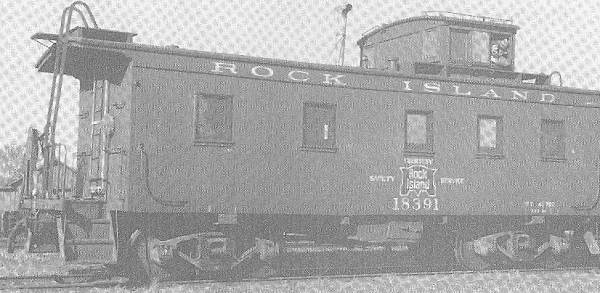
Rock Island Caboose
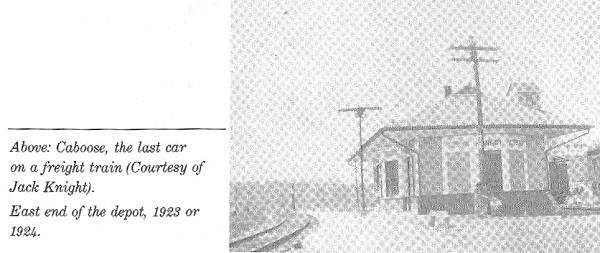
East end of Depot - 1923
The picture of the caboose is a Rock Island one. With two engines pulling the freight; there were also two cabooses.
This picture of the east end of the depot shows the coal shed to the right. The building between the depot and shed is the building that was called the Old Black Building. There, I understand was the first post office, later used as a barber shop.
A Poll Tax was used to keep the roads in shape. It started somewhere in the 1860’s. Every man, from 21 to 45 years old, was called by an overseer to work. One man worked two days; a team of horses and wagon were worth one day’s work, for a dollar a day. Crushed rock was hauled from Osby Reavis’ mine for 50 cents a yard for the roads. I don’t know just when the poll tax stopped but probably in the late 1930’s. Then, they used iron wheel tractors that pulled a blade to drag the roads, one man drove the tractor, another man hand operated the blade.
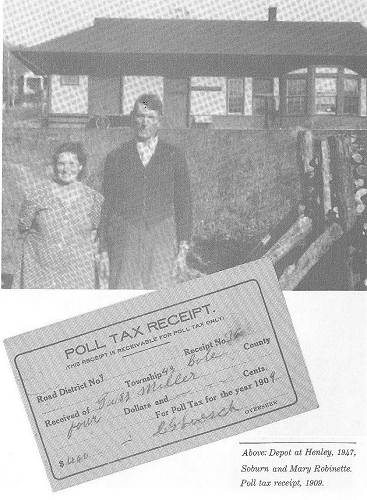
Henley Depot, 1947 - Soburn and Mary Robinette - Poll Tax Receipt
As far as I can find out, Monti Wilcox in 1938 was the first one to run a maintainer on the roads here. The maintainer had two drive wheels behind it, instead of the four they have now. Enos Gordon was the one who followed Monti Wilcox on the maintainer.
Missouri Power and Light Company came through Henley in 1930, followed by the R.E.A. electric co-op in 1948. United Telephone system came in 1965.

Saucier Cardwell and Lonnie Henley
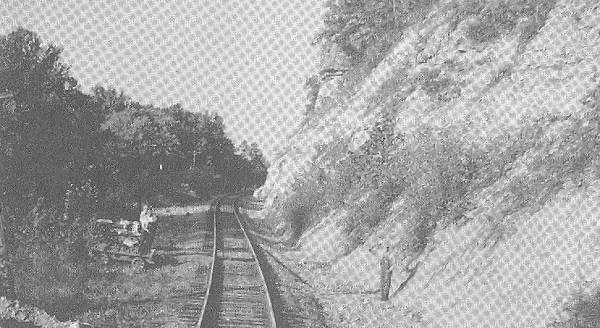
Rock Island Railway
Henley’s population was 117 in 1940, and at one time it was close to 200 or more. The Rock Island used what was called “Three Wheelers” to patrol the tracks. Alec Hickey lived in Hoecker. He used a three wheeler for transportation to work in the depot here at Henley.
The section crews that maintained the tracks used hand cars, which were pump action. They were operated by two or four men pumping in an up ad down motion. Later, they used motor cars which were run by a small gasoline engine.
I have found out that Elizabeth Hoskins Henley, John Legate Henley’s wife, is buried in the Henley Cemetery. I have met and talked to several of the Henley descendants. In fact, I met Larry Henley of Kansas City, at the Henley cemetery.
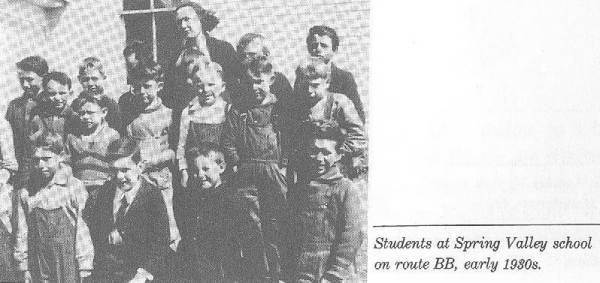
Spring Valley School - 1930's
Elizabeth is his great, great, great grandmother. I have met Louis Dey Ellison; talked to Mary Abbett, Jana Bickel and Helen Scrivner, all descendants of John and Elizabeth Henley.
We can be very proud of our courageous pioneer ancestors. They met many obstacles and endured hardships to find a new home so many miles away. They trudged through bitter cold and storms, wilderness, over mountains and dry deserts, coped with Indians and diseases. Many were buried along the way. One thing, food was plentiful: wild turkey, squirrel, quail, berries. Cold springs along the way left them worry free for food. They traveled so any miles in their wagons, drawn by horses or oxen. Women in their hand spun cotton dresses and bonnets, at times walked beside the wagons, helping the hard working, sunburned men with their hands calloused from the hard work they did. They came from Kentucky, Virginia, Tennessee and other states to settle in Missouri built homes and raised their children. Henley from Tennessee, as you might say, was the father of the little town of Henley, Missouri.
In the early 1800’s and 1900’s, small stores, schools, post offices and churches were built not too far apart. The reason for this was to be convenient to people, since buggies, wagons and horseback were the only way they had to travel except by foot.
Some of the schools were Teal, White Oak, Sanning, Oak Grove, Kempker, Pleasant Ball, Jim Henry, Waterloo, Glendale, Hoecker, and Spring Valley.

John Meltaberger, Larry Leothan and Billy Whittle

Ann Sullens Witham
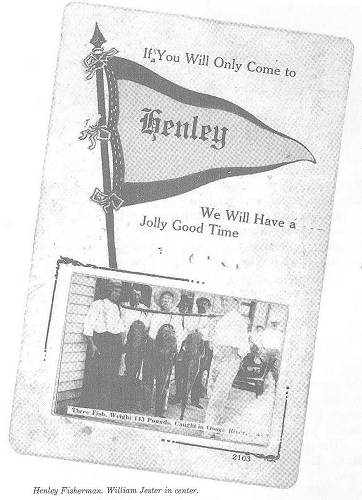
Henley Fishermen - William Jester in Center
Click image for larger view
Between Henley and Eugene, about four miles, is a tunnel on the Rock Island Railroad track. It is the same distance through the tunnel as it is across the Osage River bridge, 1700 feet. The Rock Island Railroad from Kansas City to St. Louis was a scenic beauty: high hills, hollows, forest and landscapes of river bottoms.
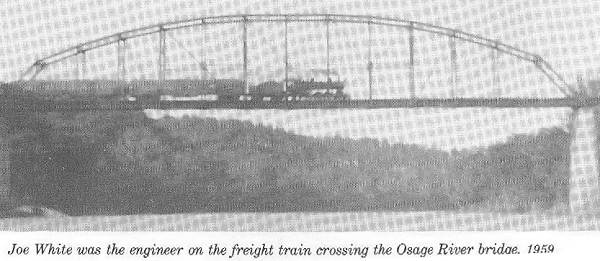
Joe White, Engineer - Hoecker Bridge - 1959
The tall steel Rock Island bridge towering over the Osage River still stands, proud of its use in the era of the Rock Island steam locomotive.
In the picture of the tunnel, the entrance is partly covered by weeds and under brush. Its inky blackness inside has the memories of trains that have passed through, lighting the still, black insides of the walls of the tunnel.
In the 1920’s Henley was a thriving town, as the train was about the only way people could get from one place to another. Some did have horses and buggies. When the automobile came in, that started the town going down hill as the larger towns beckoned.
The old steam locomotive passenger trains stopped running in 1953. They progressed to diesel electric engines on the passenger trains. Then, diesel passenger trains stopped in 1959. Diesels ran the Rock Island freight trains after the steam locomotive stopped in 1959. Some called the small diesels “puddle jumpers” or “covered wagons.”
The last Rock Island freight to run through Henley was March 31, 1979. The Rock Island railroad paid $91.94 for the right of way from William Henley to build the blackberry spur to Hickory Hill in 1910. Hoecker depot was torn down in June of 1933. On April 19, 1941, the Henley stockyard was sold. The Rock Island water tower in Henley was torn down February 9, 1953. Henley depot was torn down in April or May of 1956. It was 84 by 72 feet.
Trucks began to take business from the freight trains when it was more convenient. The Rock Island freight train made its last run through Henley in late 1972.
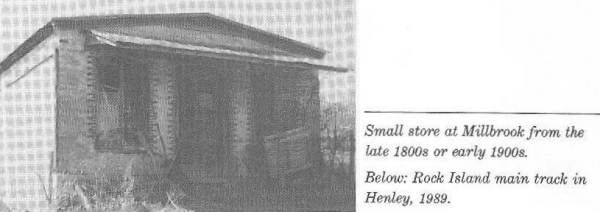
Small Store at Milbrook - Late 1800's
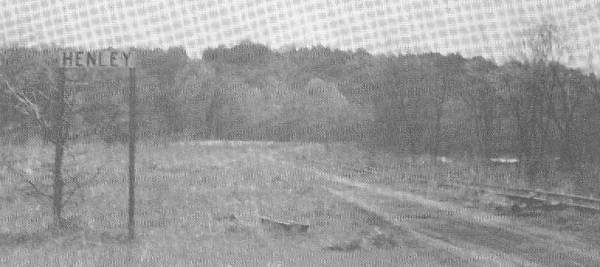
Rock Island Track in Henley
This was told to me by Joe White, engineer on the Rock Island freight train. After that, they ran what they called “The Chicken Train” from Windsor to Kansas City since they hauled young chickens. It lasted only six months. Henley was one of many small towns the Rock Island built when the train stopped running. A few close towns are Hoecker, Eugene, Argyle, Meta, Freeburg and Etterville.
Today, all Henley has left of the Rock Island’s proud history is the main railroad tracks, and the sign that reads “HENLEY.” The weeds and brush are taking over where the tracks ran. A salvage company from Minnesota removed the passing tracks in 1988.
The only activities in Henley now are the Henley post office and a car repair shop in the side room of Bruce’s store. Junk cars line the front of the Exchange. What is left of the once busy little town are empty buildings and a scattering of cars on the main street. If you have lived in this town when the streets were gravel, heard the old locomotives shrill whistle, one surely misses the hustle and bustle of Henley as it was years ago.
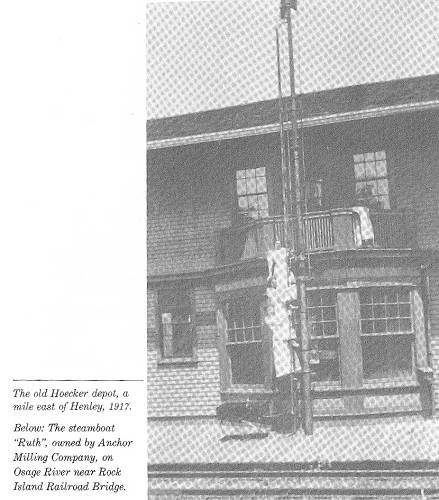
Old Hoecke Depot - Mile East of Henley - 1917
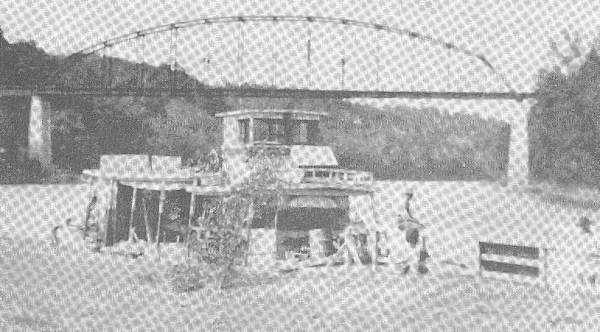
Steamboat Ruth at Hoecker Bridge
AUTOBIOGRAPHY
I will tell you a little of myself. My father was J.B. Rogers. My mother was Anna Witham (Sullens). I was born March 5, 1916, at Henley, Missouri. I was married to Markel (nicknamed “Jack”) Whittle on September 14, 1940. We have four sons: Woody, Markel Jr., Thomas and William, ten grandchildren, and four great grandchildren.
Going on four years, my driving desire was to gather enough information to write a history of our small town of Henley, Missouri, now zip code 65040. My dream has come true, and I sincerely hope that the people who read this will enjoy the history as much as I have in writing it.
Anna Mae Whittle
The other day I visited Henley taking Highway BB east off Highway 17 one mile north of Eugene which is half a mile south of Highway 54. After following Route BB for about four and a half miles I turned right to the south on Rte. H. After about a mile I arrived at Henley. The drive was very scenic with many views of the tree covered hills on either side of the road as it heads toward the Osage River Valley. A few of the older buildings are still standing in the town although some are vacant. So if you want to enjoy a scenic Sunday afternoon take a drive to Henley, Missouri near the Cole and Miller County line.
One of my volunteer activities is as a member of the Tuscumbia Alumni Association committee which is chaired by Larry Flaugher. Our association is holding a fund raiser which Larry has named the “Pig and Pickle Fest” to be celebrated at the Tuscumbia Riverside Park Saturday, September 17, 11 am to 7 pm. Beneficiaries are Miller County Special Olympics, Tuscumbia Alumni Association, and the Village of Tuscumbia. Featured will be BBQ and fried dill pickles accompanied by great music and a car show. Here is the flier Larry designed for the occasion which gives more detail (flyer).

2011 Pig and Pickle Fest Flyer
Click image for larger view in PDF format
If you want to have a really good time plan to attend the event which I anticipate will be very enjoyable and fun.
That’s all for this week.
 Joe Pryor
Previous article links are in a dropdown menu at the top of all of the pages.
|

